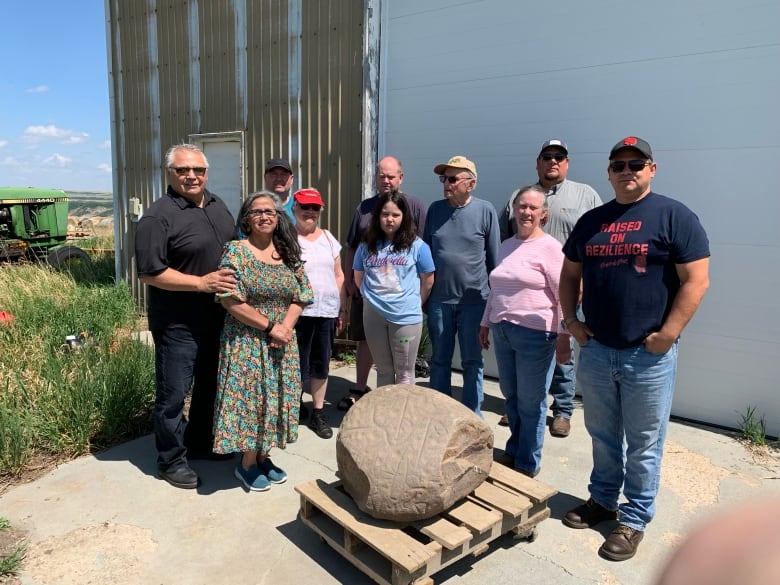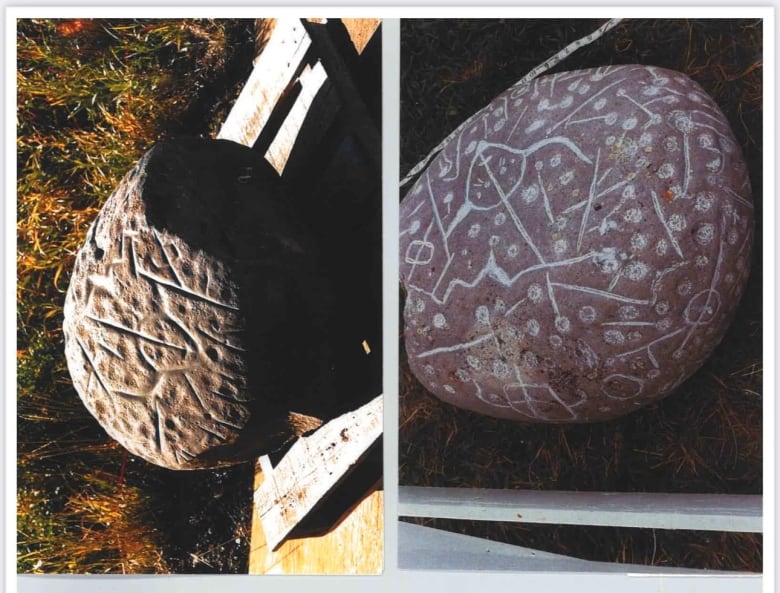How a sacred rock found its way back to its original stewards
Siksika Nation Chief thanks a central Alberta family for repatriating the artifact
Sitting on a flatbed trailer, Siksika Nation Chief Ouray Crowfoot traced the etched grooves of a sacred rock with his finger, feeling more than its old, weathered texture.
He sensed the evidence of the Blackfoot people's historical presence on the land.
"A lot of these sites that we used to have in our territory, we weren't allowed to go to anymore. So sites such as where this rock was located was a sacred site and it had not only the rock, but it had offerings around it," Crowfoot said.
"There was a buffalo jump near it, there's lots of tipi rings around it, so definitely markings of an old Blackfoot camp."
Sometime in May, Crowfoot received a letter from Frank Postill, a man who wanted to return a rock he had on his family's property near Trochu, Alta., to the Blackfoot people.

Postill's father, William Postill, came across the boulder in 1907 and eventually moved it to the family's homestead in the 1930s.
The rock, he said, was always present and featured in family photos.
"Mom said [my father] used to walk around it and look at it and look at it and look at it and wonder what it was," Postill said.
"What was the significance, what did the markings mean."

There are three main designs on the boulder. The morning star, which is a symbol found on the majority of buffalo calling sites, a buffalo head with a line down the middle which is a symbol still used in Blackfoot ceremonies today and a crow.
"The crow is the bird that helped our people to find food," said Blackfoot ceremonial knowledge keeper Kent Ayoungman as he pointed out the etchings.
"Our people have a unique kinship with the natural world."
Returning the rock
Discussions regarding what to do with the rock started 20 years ago within the family, Postill said.
He said maybe it should have been returned decades ago, but times were different and there was less cultural awareness.
"The whole attitude towards the Indigenous people has changed very rapidly in the last 50 years you know, to the betterment too you know it's much more positive," Postill said.
"We knew we were doing the right thing. I think everybody in my family thinks that way and I certainly do."
Crowfoot said the family didn't have to contact them, they could have saved it or destroyed it and he wouldn't have known.
"I really thank the Postillfamily for preserving it, preserving this history, preserving the real history of our people," he said.
The sacred rock will be displayed as an exhibit at Blackfoot Crossing historical park.
"We wanted to tell that story and bring that history back and also the more of our people that can see history, not just read it but touch history, it brings that pride," Crowfoot said.
"And I want our people to be proud to be Blackfoot."













_(720p).jpg)


 OFFICIAL HD MUSIC VIDEO.jpg)
.jpg)



























































































